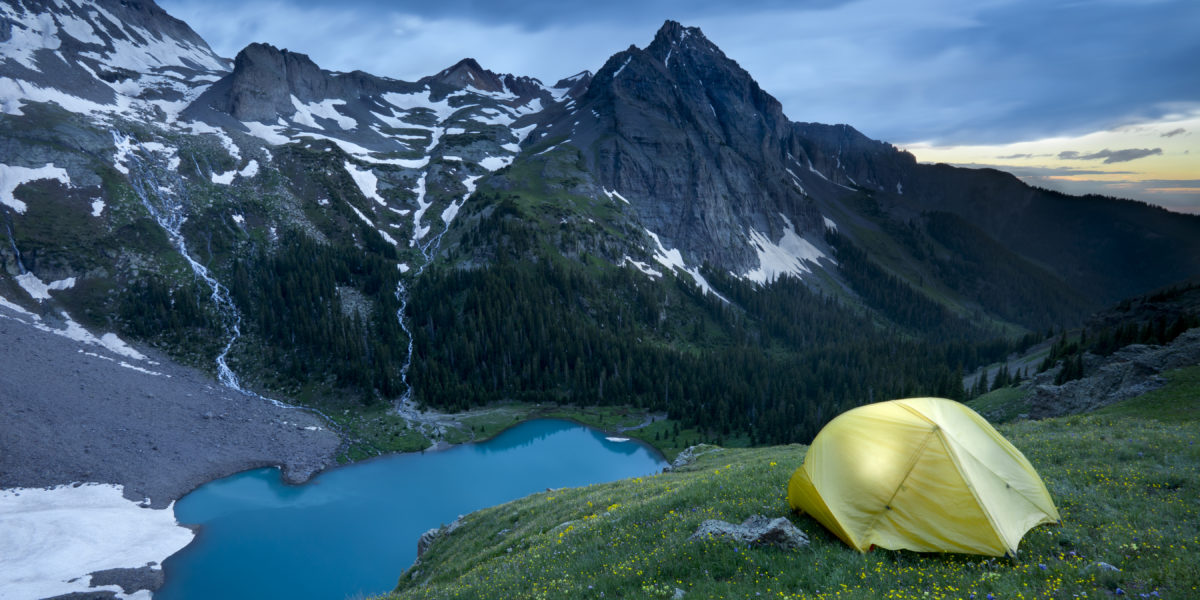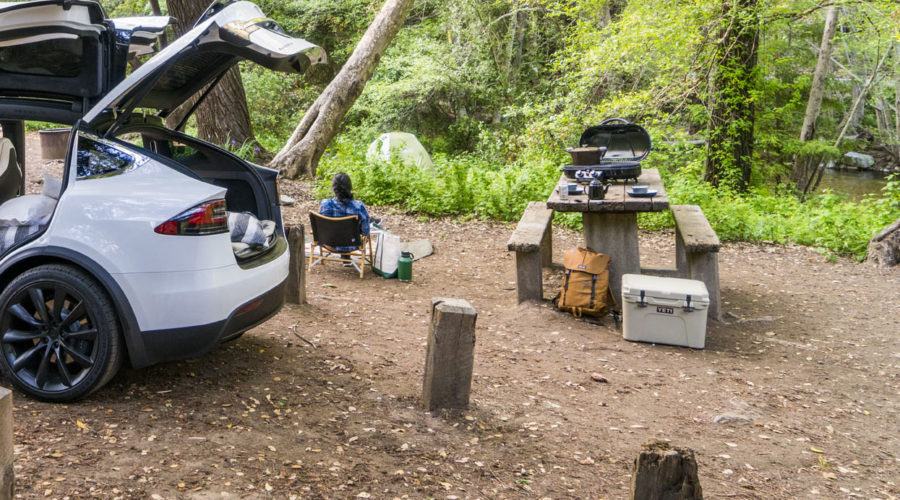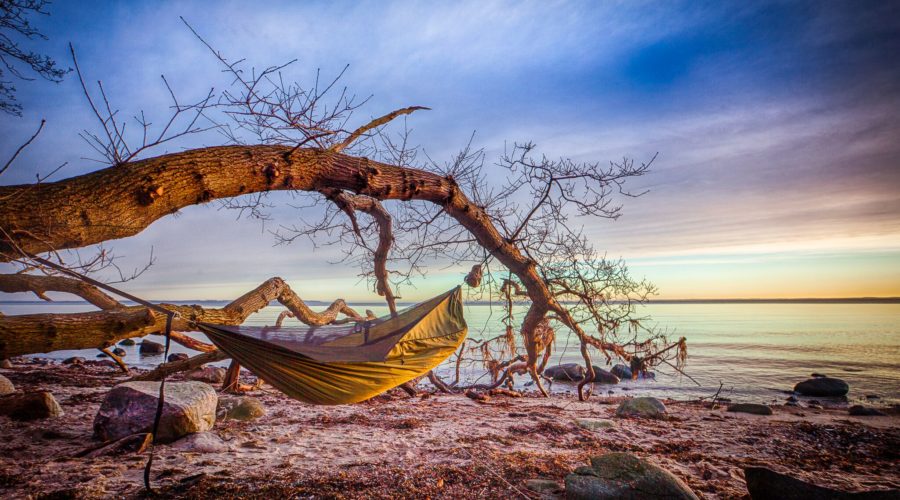
Camping Alone? What to Pack (Bear Canisters) and What to Leave Behind (Everything You’re Scared Of)
Camping by yourself can be one of the most rewarding experiences—if you know how to do it right. From tips to gear to mind tricks, here’s everything you need to camp solo like a pro.

Grant Ordelheide/Getty Images
We only recommend things we love. If you buy something through our site, we might earn a commission.
There are plenty of good reasons to go camping alone. Without anyone around to distract you, you’ll form a deeper connection with nature, gain confidence, push yourself to do things for yourself that someone else would otherwise handle, and get loads of peace and quiet. Even better—you don’t have to wait for anybody and can go about your activities as you see fit.
Yet for all the upsides, there is an equal number of intimidating factors. What if you get hurt and no one knows? Will you have everything you need? What if a bear stalks your campsite at night? Are you going to get super bored? Those are all legit concerns, and solo camping is not for the faint of heart. But if you’re a knowledgeable camper, it’s not as scary as it seems. Just make sure you have these things covered.
Know Your Stuff
Solo camping isn’t for beginners. There won’t be anyone around to help shoulder the load, so you should be good with all the standard camping skills (pitching a tent, building a fire, navigation) and then some (wildlife and plant know-how, basic first-aid training, MacGuyver-like abilities to troubleshoot and fix things). You also need to be extra alert and cautious when it comes to the common camping no-nos.
If you’re iffy on all this, start with a trial run. Set up camp in your backyard or ask an outdoorsy friend to camp nearby for a couple of nights before you’re totally on your own.
Pick the Right Campsite
Even if you’re a seasoned camper, when you’re alone it’s best to stick to campsites you’ve been to before. You’ll have a solid grasp of the terrain, know where to find things like water or dry wood, and have a better sense of any areas to avoid. Don’t worry about having a redundant experience; it’ll feel like a new place when you’re by yourself.
It’s also wise to set-up camp within a relatively short walk of other campers or rangers—especially if you’re hellbent on a new-to-you site. If something does go wrong, you can get to help quickly or have someone hear you if you yell out.
Other factors to look for in your perfect site: a nearby water source and an east-facing locale that gets sun early in the morning when it’s likely to be chilliest. If the forecast calls for heat, look for plenty of shade cover.
Pack Smart
Without camping buddies to carry some of the load, you have to master the art of thrifty packing. Double- and triple-check you have all the essentials (there’s no one to lend you whatever you forget), but keep it light. Start with our printable definitive packing list and pare down depending on your needs. Having extra water is never a bad thing. But if you camp close to a water source (which you should do anyway), you can mostly rely on a small water filter, like a LifeStraw, or purification tablets instead of having to lug around the recommended 5 gallons per day. Maintaining a hearty supply of food is also crucial, and you’ll want to keep your rations safeguarded from bears, raccoons, and other curious critters. Bear canisters, though bulky, are worth the extra weight to keep animals out of food, trash, and other scented items. If you’re planning on a long solo camping trip, consider car camping instead, so you can keep extra supplies in your car.
Alert a Friend
You want to do this camping thing on your own—we get it and admire you for it. But as nice as it is to fall off the grid sometimes, it’s not wise to do so while camping solo. In case of emergencies, there should be someone who knows where you are. You don’t have to tell everyone. Just pick one or two trusty friends back home. Give them your itinerary (yes, it’s also a good idea to create a detailed itinerary with specifics on planned hiking routes, water sources, elevation gain, where you’ll sleep, landmarks—the goal is to reduce risk). Make a plan to check-in at specific times during the day and decide ahead of time what your friend should do if you don’t respond.
Think beyond the Traditional Tent
Tents are awesome for groups, but for a party of one, they can be unnecessarily bulky and annoying (it’s so much easier to set one up with help). Instead, look for lighter alternatives like those popular with backpackers. Is there favorable weather on the horizon? Maybe all you need is a tarp and a sleeping bag or a bivy sack. Need a little more support? Single-sleeper hammocks and tent cots are both solid options. Plus, the designs keep getting plusher. Backpackers swear by the Warbonnet Outdoors Blackbird hammock (pictured above). It’s super spacious, keeps its shape so you can sleep comfortably on your back, and easy to set up.
Stay on Track
You have your itinerary. You have a friend who has agreed to keep tabs on you. You even have your cell phone ready to turn on in case of an emergency. That’s all great, but for added peace of mind, invest in an SOS device for your solo camping trip. Not to be all doom and gloom, but you need to prepare for the worst. Neither your cell phone—which will likely have limited or no service wherever you’re camping—nor your friend, will be of much help if you wander off your route, get hurt, and need immediate help. A personal locator beacon or satellite messenger allows you to send a distress signal from anywhere. PLBs are more affordable, but they’re intended for one-time use to send a one-way distress signal. A satellite messenger starts at about $150 and requires a subscription to tap into its network, which will allow you to constantly track your location, send updates to the fam, and call for help.
Master Your Mind
Nothing will ruin a good solo camping trip like sleepless nights spent wracked with fear. Whether it’s the things that go bump in the dark or recurring flashbacks to all the adventure survival movies you’ve ever seen, there are plenty of legit creepy scenarios you’ll face in the wild. This is the perfect opportunity to master mindfulness. Get a good meditation routine going before you head out, so you can employ those skills when anxiety strikes. Remember that if you’re smart and cautious (don’t leave food out for the bears, for example), you’re likely to be just fine. Focus on your immediate surroundings—the trees, the feeling of the wind on your skin, the bird songs—and come up with a mantra that will ease your nerves if you start to freak out.
Plan to Entertain Yourself
Even those who love to be alone with themselves and love the outdoors can face loneliness and boredom in the woods. We’re social creatures, accustomed to being around people—and being on our phones. It’ll take time to adjust. Bring a book, sketchpad, or anything else that will get you through those lulls. This would also be the perfect opportunity to work on your outdoor photography, beef up on your plant ID knowledge, or any other activity you’d have less time for if you were camping with a crowd.
Stick It Out
Avid solo campers suggest you stay out for more than a few nights. A full week is recommended. Again, you need to adjust to your new surroundings, the quiet, the spooky first couple of nights. At first, you’ll be preoccupied with all the unknowns and exhausted from the worry and possible interrupted sleep. When you get comfortable, you’re more likely to start to enter that zen-like state when you’re in tune with nature and can reap the full benefits of your adventure. Though we’re accustomed to indoor-dwelling, tech-connected lives, we’re biologically geared for life in the wild. Give it a few days, and your body will soon get the memo that you’re home.
Make an Exception
Purists might disagree, but we think it still counts as a solo camping trip if you take your dog. You’ll feel safer knowing you have your four-legged best bud by your side. And, it’ll be much easier to make friends along the way. Sure, your canine will somewhat disrupt your plans (you can only go to pet-friendly areas and will have to adjust your hiking routes to ensure they have water and remain comfortable), but it’ll be so worth it to see the joy on your friend’s face when he or she gets to run around in the wild with you.


